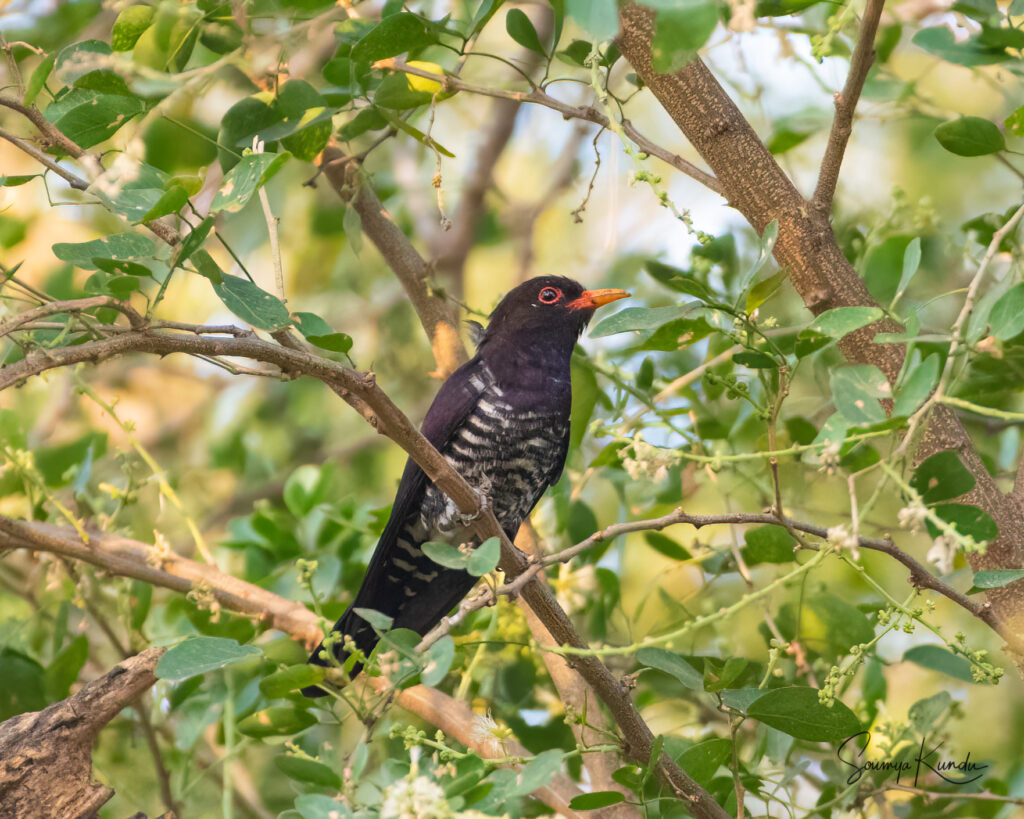
Our house in Salt Lake enjoys the privilege of being located next to a vacant plot. Attempts have been made several times in the past to tame that small patch by cutting down the weeds and shrubs, burning them, and even plundering trees with JCB. Nature being a stubborn donkey still finds its way. A Jungle Jilipi/Babla (Pithecellobium dulce) tree stands on that patch. It has been standing for a long time. It has weathered many storms, broken down, and recovered with equal gusto.
I have seen so many bird species over the years on this particular tree that I have grown extremely fond of it. I have mentioned several times in the past that this particular tree, the Jungle Jilipi is a bird magnet. Over the years, I have initiated my son into bird-watching just by pointing him at the birds that visit the tree. Life might have been different without this tree. The spiral Jilipi like fruit resembles tamarind with reddish skin. Once the outer case is stripped off, white edible flesh is visible. Children in the villages do eat the white flesh. Even a decade back, lesser privileged children could be seen pelting stones in an attempt to get hold of the fruits. Inside the white flesh lies slightly triangular flat-shaped black seeds. Natural germination in this soil and climate is excellent.
The fruits start appearing at the end of March and continues for the next three to four months. Fruits are produced in abundance. This is the time one can see the maximum number of birds. The Rose-Ringed Parakeets are regulars. Even late in the evening, we see them from the rooftop almost at eye level or slightly higher, enjoying the fruits. Like humans, the birds also strip away the outer casing and consume only the white flesh surrounding the seed. We have also recorded Alexandrine Parakeets feeding on the fruits. The Coppersmith Barbet, Blue-throated Barbet, Asian Koels, and Red-vented Bulbuls can be found in plenty during the fruiting season. The Asian Koels remain inside the tree for the entire duration of the day and night during springtime. Their calls are unmistakable. I do not understand the bulbuls because I find them on the tree in large numbers even outside the fruiting season. In spring, the Oriental Magpie Robin perches on the topmost branch and continues with his song. Oriental Magpie Robins keep flitting around the tree but I have never seen them eating the fruits. They stick to insects, I guess.
The scene around this tree is no less spectacular when it is flowering from around December to March. Flowering is profuse. In this period, our regular visitors are the Purple Sunbird, Purple-rumped Sunbird, and Common Tailorbird. Even House Sparrows can be seen, but probably they are after the insects. The flowers attract a lot of insects which in turn bring winter visitors like the Taiga Flycatchers, Blyth’s Reed Warblers, and Thick-billed Warblers. Taiga Flycatcher and Blyth’s Reed Warbler are quite common in this period. An occasional Brown Shike can also be spotted sitting motionless on the lower branches but they are rare nowadays. During winter, a group of four to five Green Bee-eaters come regularly in the morning to sit on the tree canopy and hawk insects in flight. They are nowhere to be seen for the rest of the year. Black-hooded Orioles are quite common. Also, an adult and a juvenile Golden Oriole have been visiting regularly during this winter. They spend several hours in the tree. I hardly try to spot them but I can sense their presence from their screech-like calls.
The only raptor I find in this tree is an occasional Shikra. The Shikras are common in our neighborhood but very rarely do Shikras perch on this tree. Probably, they do not like the thorns which cover the young branches or they love trees with bigger leaves and denser canopy. Just my guess. The Shikras mostly perch on the large Jamun tree (Syzygium cumini) nearby.
Would you be surprised if I tell you that we have even seen and photographed two kingfishers on this tree? The White-throated Kingfisher and the Stork-billed Kingfisher. The White-throated Kingfisher uses the lower branches as a perch to swoop down on the lizards. The Stork-billed Kingfisher comes rarely but it does come. My neighbor even has a beautiful photo of it perched on this tree.
The monsoons bring in more insects and insect larvae. Pithecellobium dulce appears prominently as a larval host plant for four to five species of butterflies. The butterfly which I find regularly in monsoon is the Common Grass Yellow and I am sure they lay the eggs on the Jungle Jilipi. I have also observed Indian Jezebel and Tailed Jay during the flowering season. The monsoon also brings in dense undergrowth. A pair of Greater Coucals and the chatty Jungle Babblers keep us engaged throughout the day. The wet floor provides them with juicy insects. The Black-rumped Flameback also visits during this period.
Some star visitors have also visited this tree, but only once. In the recent past, I remember photographing a Black-winged Cuckooshrike (7th April 2021) and a Plaintive Cuckoo (22nd Nov 2021) from our window. Needless to say, I was elated on both occasions.
When the first news and images of the Violet Cuckoo being spotted in Salt Lake spread, I was excited. What immediately struck me was the tree. It was a Pithecellobium dulce. Since the first sighting, the bird has remained faithful to the Jungle Jilipi. There is one large Jungle Jilipi and two smaller Jungle Jilipi trees in the vicinity which feed the bird well with insects, mostly caterpillars. My favorite tree is now playing host to the most sought-after and photographed bird in town!!
The tree in our backyard has overgrown and invaded our rooftop. The climber from our garden mingles freely over the Jungle Jilipi tree. I do not mind. Nor do the birds seem to mind.
Soumya Kundu
22nd March 2022

